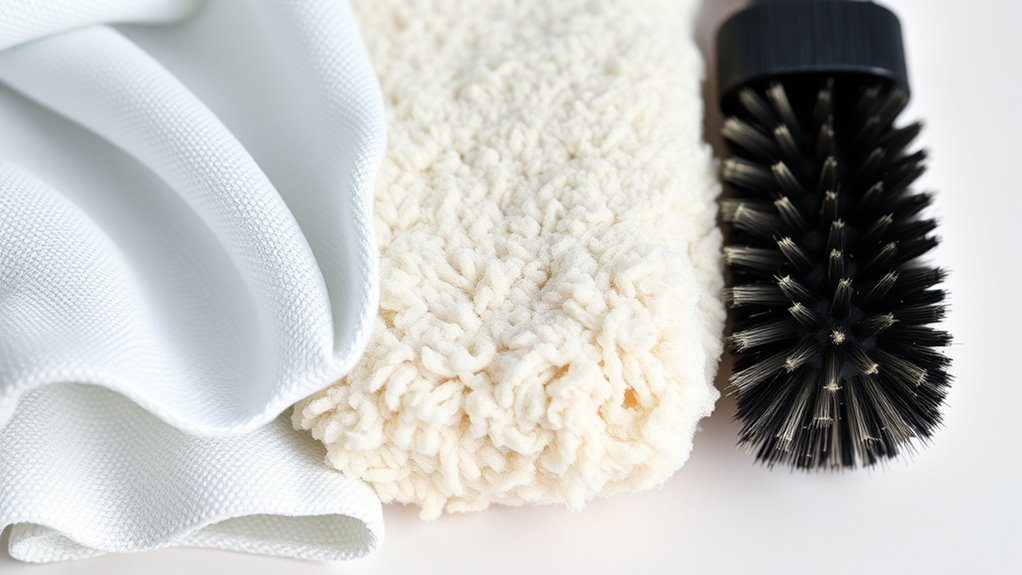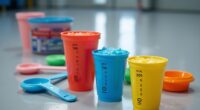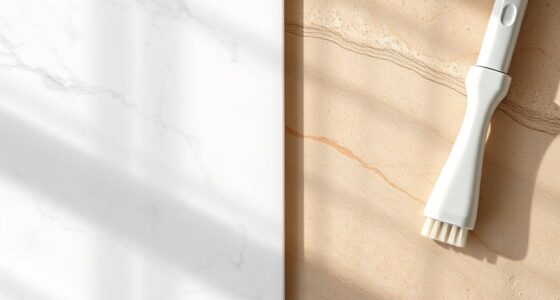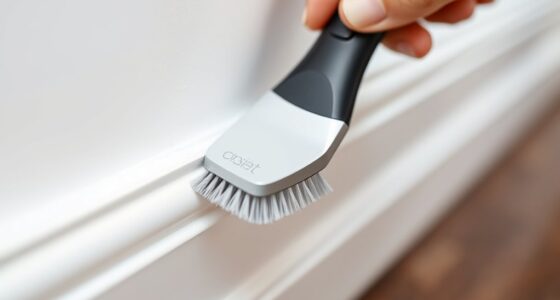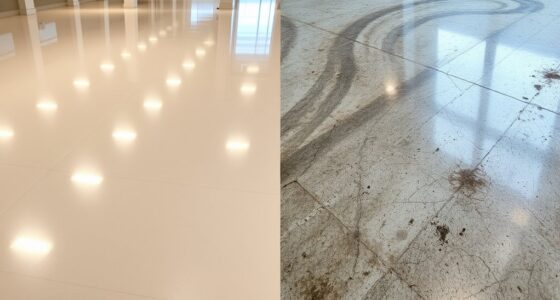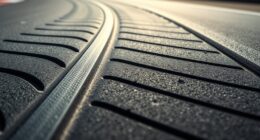When choosing between microfiber, pads, and brushes for specialty tasks, consider the surface and cleaning needed. Microfiber is gentle and great for delicate surfaces like glass or electronics. Pads offer more scrubbing power for tougher residues but can cause micro-scratches if used improperly. Brushes, especially soft-bristled ones, help clean crevices and textured areas without damage. Understanding when to use each media helps prevent damage and guarantees effective cleaning—exploring further reveals tips for peak results.
Key Takeaways
- Microfiber is ideal for delicate surfaces, offering gentle cleaning without scratches, while pads provide more abrasion for tougher grime.
- Brushes with soft bristles are suitable for crevices and textured surfaces, but stiff bristles can damage fragile materials.
- Selecting the appropriate media depends on surface sensitivity and cleaning task intensity to prevent surface damage.
- Microfiber excels at trapping dust and microbes, making it perfect for electronics and glass, whereas pads and brushes handle stubborn or embedded dirt.
- Combining media types can optimize cleaning efficiency, using microfiber for gentle wiping and pads or brushes for more abrasive tasks.
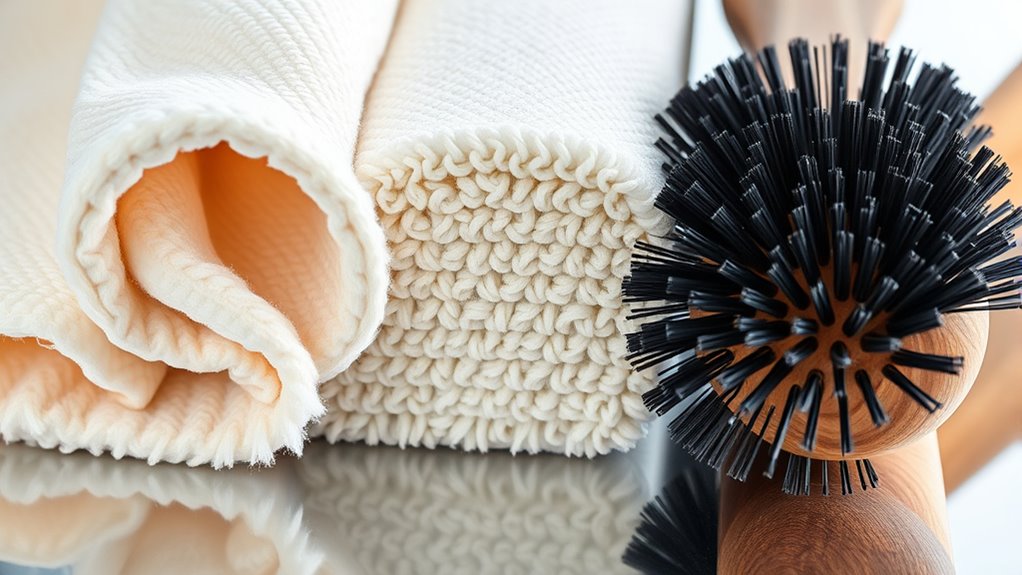
Have you ever wondered why certain media are essential for specific laboratory tasks? It all comes down to understanding the unique properties of each cleaning tool and how they interact with different surfaces. When working with delicate surfaces, choosing the right media can make the difference between a pristine result and damage that requires rework. For example, microfiber cloths are known for their gentle yet effective cleaning capabilities. Their soft fibers can trap dust, dirt, and microbes without scratching or harming sensitive materials. This makes microfiber ideal for delicate surfaces because it provides abrasive cleaning without the harshness of abrasive agents or rough textures. You can use microfiber to wipe glassware, electronic screens, or polished surfaces, knowing it won’t leave scratches or streaks. Their versatility extends to absorbing liquids and picking up fine particles, making them a go-to option for meticulous cleaning tasks.
On the other hand, pads offer a different set of advantages. They are generally more robust than microfiber, suitable for cleaning surfaces that can tolerate a little more abrasion. When you need to remove stubborn residues or perform more intensive cleaning, pads provide the necessary abrasion to scrub away contaminants. Yet, they’re still designed with the understanding that some surfaces are delicate. For instance, soft foam or non-abrasive pads can be used on sensitive laboratory equipment to prevent scratches while effectively removing dirt. The key is selecting a pad with the appropriate texture and material composition to match the cleaning task. Using abrasive cleaning methods on delicate surfaces can cause micro-scratches, which accumulate over time and compromise the integrity of the material. As a result, choosing a pad that balances cleaning power with surface safety is essential.
Brushing introduces yet another approach, offering mechanical agitation that’s especially useful for removing debris from crevices or textured surfaces. When you need to dislodge particles trapped in grooves or uneven surfaces, brushes are invaluable. They can be designed with soft bristles that avoid damaging fragile materials while still providing enough scrubbing action to loosen debris. For delicate surfaces, selecting a brush with gentle bristles ensures you don’t cause microabrasions or compromise the surface’s finish. Brushes are often used in conjunction with cleaning solutions for more stubborn contamination, but it’s important to match the brush’s stiffness to the surface’s delicacy. Using a stiff-bristled brush on sensitive surfaces can lead to scratches or deterioration, so always opt for softer bristles if the surface demands it. Additionally, understanding the horsepower of electric dirt bikes can help in selecting appropriate equipment for heavy-duty cleaning tasks involving motorized tools.
Frequently Asked Questions
Which Media Is Best for Delicate Surface Cleaning?
For delicate surface cleaning, microfiber is your best choice. It provides gentle cleaning and minimizes surface sensitivity, reducing the risk of scratches or damage. Microfiber’s soft fibers trap dirt effectively without abrasive action. Avoid pads or brushes that might be too harsh or abrasive. Use microfiber with light pressure and gentle motions to guarantee thorough yet safe cleaning, preserving your surface’s integrity and appearance over time.
How Do I Choose the Right Media for Heavy-Duty Tasks?
To choose the right media for heavy-duty tasks, consider its abrasive effectiveness and media compatibility. You want a media that can handle tough grime or rust without damaging the surface. Look for options like brushes or pads designed for aggressive cleaning, ensuring they’re compatible with your material. Always test in a small area first, and select media that balances durability with effectiveness for ideal results.
Are There Safety Concerns With Using Brushes on Certain Materials?
Using brushes can be risky, like walking a tightrope, especially if you’re not mindful of material compatibility. Certain materials, like delicate plastics or soft fabrics, may get scratched or damaged. Always check safety precautions and test on a small area first. By understanding material compatibility, you guarantee safe, effective cleaning without risking harm, making your task smoother and safer.
Can Microfiber Media Be Reused or Recycled?
Yes, microfiber media can often be reused or recycled. You should follow reuse guidelines to extend its life, such as washing it properly after each use. Recycling options vary depending on your local facilities; some may accept microfiber for textile recycling, while others don’t. Always check with your recycling center and manufacturer’s instructions to guarantee you’re disposing of microfiber responsibly, reducing waste and environmental impact.
What Maintenance Is Required for Pads and Brushes?
Oh, the irony—pads and brushes seem low-maintenance until you realize they need regular TLC. To boost pad longevity, you should clean them after each use with appropriate cleaning techniques, avoiding harsh chemicals. For brushes, gently remove debris and deep clean with soap and water regularly. Proper maintenance ensures your tools stay effective, saving you money and frustration while keeping your work excellent.
Conclusion
Choosing between microfiber, pad, and brush depends on your specific task, your desired finish, and your comfort. Microfiber offers gentle cleaning, pads provide even pressure, and brushes deliver precision. Each media has its strengths, each media has its purpose, each media enhances your results. By understanding their differences, you can select the right tool, refine your technique, and achieve the best outcome. Ultimately, your success depends on your choice, your effort, and your attention to detail.
